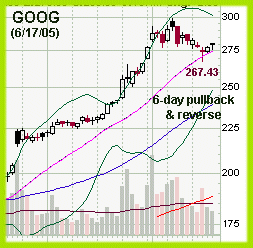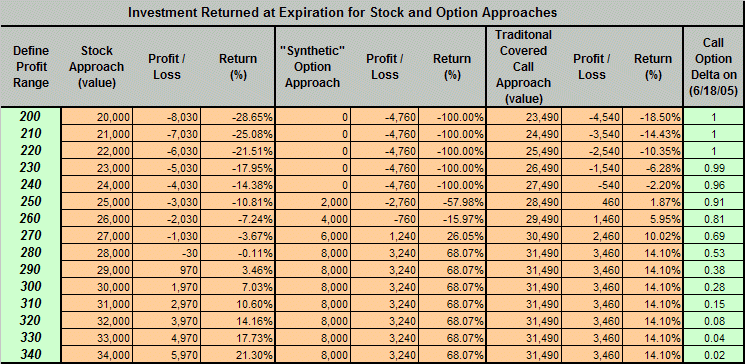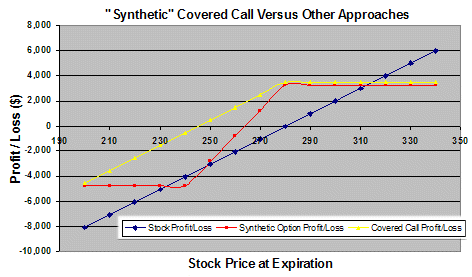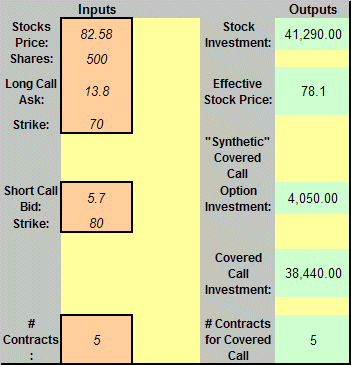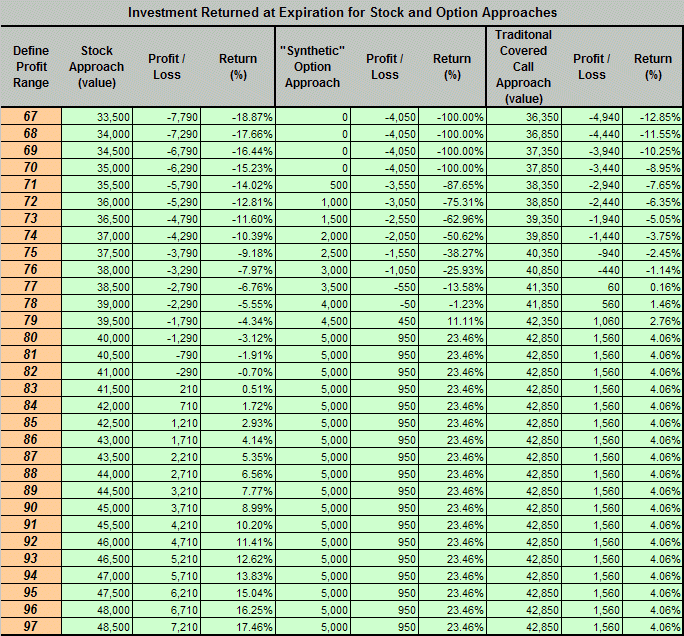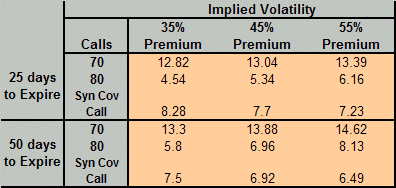TripleScreenMethod.com
I described the Synthetic" covered call strategy (a bull call spread) in some detail two months ago (6/24/05 TSM report and 7/29/05 TSM report). Since then we've made a number of trades utilizing the method so I thought that it would be worthwhile to look at other features of the trade. Specifically, I want to look at the array of possibilities that present themselves for a stock (here POT) and some of the criteria used to choose between them.
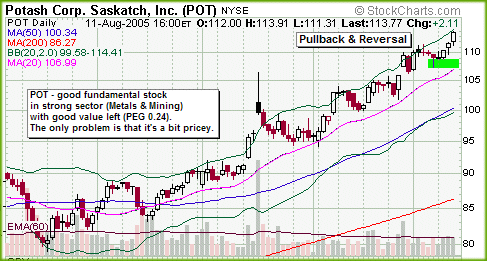
POT had been making a bullish run for several months. Recently, though, it's been pulling back into the area marked in green. In today's economic environment, POT's sector, metals & mining, has rotated into favor as well. The question a trader asks: Does one want to commit cash to buy shares of such a pricey stock? The "synthetic" covered call offers an alternative requiring far less cash.
Ideally, we would put the trade on just as its pullback reversed itself, but here we'll look at the opportunities that present themselves well after the pullback reversed on 8/11/05: POT closed at $113.77, up $2.11 for the day. Let's say that we normally trade 500 shares of stock. In POT's case, probabilities favor it climbing further from here. I could just buy 500 shares at $56,885. Instead though, I could opt to buy one of the Sept calls shown in the table below, let's say 5 contracts of the $100 call at $14.80 per share or $7,400 (500 x $14.80). Buying a call contract forces the seller to sell me 500 shares of POT at $100 per share over the next 35 days, and for this right, I pay a $14.80 premium. My breakeven point for the call is $114.80. The benefit: much less cash required for the position; the downside: my breakeven point is over a dollar higher than today's close.
I could instead create a "covered" call. That is, I could buy the 500 shares then sell the Sept $115 call for $3.4 a share ($1,700 for the 500 shares). Shorting the call obligates me to provide the buyer my 500 shares anytime over the next 35 days for $115 per share; hence, the short call is covered by the shares. The benefit: I've reduced my stock basis from $113.77 to $110.37 ($113.77 - $3.40) and lessened the cash needed to $55,185 ($56,885 - $1,700); the downside: it's still a lot of cash, and I've limited my upside to $115, i.e., I have to provide the 500 shares at that price, even it its price rises to $200 by the time of expiration.
Let's now consider what I think is a better alternative than the three positions described above, the "Synthetic" covered call. Instead of covering a short call with shares that I own, I cover it with a long, deep in-the-money call that provides me the shares by expiration. One buys the lower valued strike and sells a higher valued one, both expiring in the same month. Because a whole range of strike prices are available for each of several months in the future, there are a range of possibilities for "synthetic" covered calls.
The following table presents the possibilities available to POT utilizing September and December Calls, the first expiring in 35 days, the second in 126 days. Each column--starting with the fourth--represents data for the two calls joined in black or grey, e.g., column four is the long $95/short $100 combination, while column seven is the long $95/ short $115 combination. The first position requires $2,650 to put on, has an effective share cost of $100.3 but is guaranteed to lose 5.7 percent because of the spread in the bid/ask prices. The second position fares better. It requires $8,000, has an effective share cost of $111.00, and returns a maximum profit of 25 percent over the next 35 days if POT closes above $115. One gets better yields by increasing the effective price, but at the same time, the risk of winning falls. I prefer the $105/$115 combination: 42.9 percent profit potential, $3,500 cash necessary to set up the position, $112 effective price with $115 maximum cap. In essence, I put up $7 to earn $3 but have some downside protection. Going further out in time to December appears to give better performance, but I can place three, one-month trades over the time it takes to make a single three-month trade.
The benefit of the "Synthetic" covered call: far less cash required ($3,500 for $105/$115 combination), some downside protection with a reduced effective share cost ($112 versus current $113.77), and a cap on any possible loss (here my $7/share cost); the downside: size of the win is capped by the strike price of the higher strike (here $115).
One can improve the performance by going long the lower-price strike when POT hits our TSM buy point, but waiting for this initial thrust up to play out before shorting the higher-price strike. This approach is called "legging" into the trade.
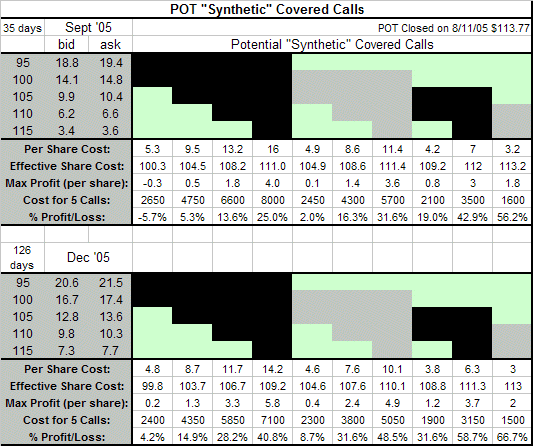
Several of you asked about the option approach that I outlined for taking advantage of GOOG's recent pullback. I'll go into thattrade further here, since GOOG presents problems for most of us, because it's both expensive and volatile (~$280 a share). Onthe other hand, fundamentals are great; earnings estimates are continually being increased; value remains, even at these prices;and the technical pullback pattern is classic. Option approaches offer an ideal fit for this situation, as they can both limit the cashneeded and do a better job of controlling the downside risk. As evidence, contrast three approaches: buying the stock itself,buying the stock and selling Calls ("covered" Calls), and buying in-the-money Calls while selling at-the-money Calls.
GOOG has been on a bullish tear since coming public last year, even more so since forming its breakaway gap (left side of chart) last month. Over the last two weeks, however, it's been consolidating those gains in six days of lower highs. That trend reversed when a bullish, "hammer" candle formed last Wednesday at the support of its 20-day moving average. That pullback has now been followed by two days of reversal.
Let's contrast the three approaches to entering a GOOG position (two utilizing options): (1) buying 100 shares of GOOG outright, (2) buying the shares and selling 1 Call contract (July $280 strike) against them in a conventional "covered" Call, and (3) combining 2 long July $240 strike Calls with 2 short July $280 strike Calls in what I'll call a "synthetic" covered Call. Note, I executed two calls in the last because the cash required is far less: $28,030 for the stock position, $25,540 for the "covered" Call, and $4,760 for the "synthetic" covered Call.
GOOG daily chart through 6/17/05.
I could have executed the following trades just before Friday's close (6/17/05) when GOOG closed at $280.3: long the $240 Call at a cost of $58.7 per share (ask price) in 100 share contracts and short the $280 Call, generating a $34.9 per share premium (bid price). The "synthetic" covered Call buys 2 $240 Calls at a total cost of $117.40 per share or $11,740 for the two contracts and then sells 2 $280 Calls for a premium of $69.80 or $6,980 for the two contract. Total cost for the "synthetic" covered Call position is $4,760 ($11,740 - $6,880).
The table below shows the profit potential for the three strategies over a GOOG price range between $200 and $340 at the July expiration in 26 days (July 15, 2005). Several points are obvious: (1) both option approaches remain profitable even if GOOG drops by $10 to $270 at expiration ($267.43 is the technical stop), while the stock purchase loses money there (option strategies control risk better); (2) both option approaches limit the upside, not so for the stock purchase; (3) the "synthetic position involves less initial cash and gives the superior return. Note, the last column provides the option deltas for Call strikes falling between $200 and $340; this is also the probability that the Call will finish in the money, i.e., there is a 0.15 probability that GOOG's price will reach $310 by expiration.
*Find Excel program that generates this table at the option page under synthetic covered call.
The chart to the right shows the profit/loss generated by the three strategies over the range of potential values at expiration. Stock ownership in blue varies linearly; the "covered" call in yellow is capped on the high side; the "synthetic" call in red is capped on both the high and low sides. Again, the last requires far less cash in the beginning, offers downside risk control that the other two don't, and generates a positive return even if the stock should drop $15 by expiration.
I would use the stock as a trigger for unwinding the position, i.e., if GOOG's price fell below $267.43, I would unwind the position.
"Synthetic" Covered Call (7/29/05)Several of you have asked me to explain this option strategy. Just what is a "synthetic" covered call and why should the average trader be interested? Well let me answer those questions here and in the process add some additional information. Several option tools and valuable informational links can be found at the TSM option page. A full introduction to options and the host of strategies we'll be implementing here can be found in my new book ("Options: What are They and How can the Average Investor/Trader Profit from Their Use?") at this same link.A covered call, you'll remember, is a conservative strategy used to earn income from stock holdings and at the same time reduce the risk somewhat of holding the shares. For example, say you owned 100 shares of KBH and paid $82.80 at today's open. You could have sold the September $85 call and received $2.90 a share for the 100 share contract. That would have obligated you to sell your shares for $85 by September 16 (50 days from now). Your profit would be limited to $5.10 ($85 - $82.80 + $2.90) a share or 6.4 percent earned over 50 days (46.7 percent annualized). That's not bad for a pretty safe trade, but it would require a cash outlay of $79.90 per share ($82.80 - $2.90). Your downside is slightly protected by the option premium earned, i.e., over the next 50 days, the price of KBH could drop to $79.90 and you would break even, while someone owning just the shares would be down $2.90 a share. The downside, other than requiring a big cash outlay for the stock, is that the profit is capped to the upside. If KBH climbs to $100 over the next 50 days, you're still forced to sell at $85 a share. Let's look at another strategy designed to accomplish the same thing but with a higher return and requiring less cash.
The "synthetic" covered call (really a debit Bull Call Spread) substitutes buying a deep in-the-money call for stock ownership. For KBH, instead of buying the stock itself, we bought the September $70 call for $13.80 a share ($1,380 per 100 share contract) and sold the September $80 call for $5.70 a shares ($570 per 100 share contract). Both expire in 50 days, and both are in-the-money right now. My total cash outlay is $8.10 per share ($4,050 for 5 contracts). Over the next 50 days, I'll receive max profit if KBH stays above $80 per share. It's $1.90 per share ($950 for 5 contracts) or 23.5 percent (171.2 percent annualized). Further, our max loss is capped at $8.10 per share (usually less because a technical stop is used employing the underlying stock), and our max profit is capped at the $80 stock price. Compare this approach with paying $41,290 ($82.58 per share shortly after the open) for 500 shares of the stock. The following Excel table calculates the profit potential of a "synthetic" covered call position. It's available at the TSM Option page. Just fill in the information embedded in the red background.
Once this table is filled in the following table is generated. Profit potential is calculated for stock ownership, the traditional covered call, and the "synthetic" covered call over a range of potential prices at expiration (here from $67 to $97). Profit/loss charts are also provided.
There's two further pieces of information important to this strategy. How do time to expire and the size of implied volatilities impact the return? Recall an option's implied volatility is directly related to its premium. It changes with supply and demand, as well as several of the option's inherent characteristics. An option's implied volatility is the range the the stock is expected trade over the next year, e.g., a stock priced at $100 a share with its option's implied volatility at 35 percent is expected to trade between $65 and $135 (+/- 35 percent) over the next year. As shown in the following table--developed for the KBH "synthetic" covered call--value falls with this strategy when implied volatilities decrease or expiration time lengthens.
Let's now look at a real world example of the "synthetic" covered call, the GOOG trade we entered on 7/14/05. The following table summarizes our results.
One could have bought 200 shares of GOOG on 7/14/05 for a total cost of $60,950 when it was climbing every day in anticipation of its earning report. Instead, we established the Aug 270/300 "synthetic" covered call at 6 contracts for a total cost of $11,880. Both had profitable 1st half trades: +2.40 percent and +12.1 percent, respectively. But both trades turned bad as analysts were less enthused by the earnings report. On 7/29/05, the 2nd half of both trades were stopped out: a 14.81 percent loss for the shares and a 10.10 percent loss for the option position. In summary, one needed far less cash for the option position and even though the trade was marginal, the option trade made money ($240) while the stock trade lost money ($756). Enough said as to why I prefer the "synthetic" covered call to regular stock ownership, especially when the implied volatilities are favorable.
